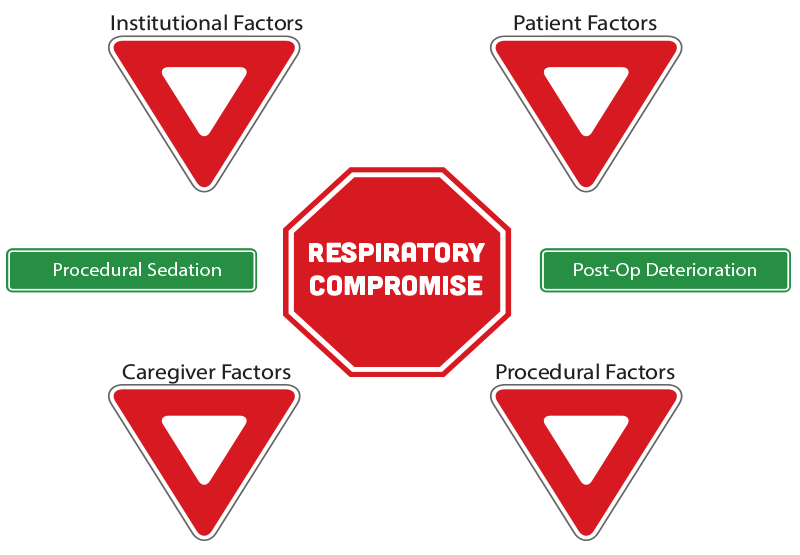Click on the various shapes for more information.

Institutional Factors
Institutional risk factors for respiratory compromise include underfunding, a distant location of monitoring stations or equipment relative to staff and patients, various environmental factors (noise, lighting, temperature) and a lack of protocols relating to medication administration and patient monitoring.
References
Association for the Advancement of Medical Instrumentation. (2010). Infusing patients safely: priority issues from the AAHI/FDA infusion device summit. Arlington: AAMI.
Canadian Medical Protective Association. (2016, September). Safe use of opioid analgesics in the hospital setting. Retrieved from Canadian Medical Protective Association: https://www.cmpa-acpm.ca/en/advice-publications/browse-articles/2016/safe-use-of-opioid-analgesics-in-the-hospital-setting
Lynn, L. A., & Curry , J. P. (2011). Patterns of unexpected in-hospital deaths: a root cause analysis. Patient Safety in Surgery, 5(3).
Patient Factors
Patient-related factors that elevate the risk of respiratory compromise include the patient’s age (with the very young and the elderly at highest risk), history of cigarette/alcohol use and the need for medications that suppress the drive to breathe (e.g. opioids). Patients who require airway protection or intubation and those who do not understand their course of treatment (procedures, medications, risks, etc.) are also at elevated risk for respiratory compromise. The following comorbidities are also associated with an increased risk: cardiovascular, lung, liver, kidney or neuromuscular disease; cancer, diabetes, obesity, sepsis, organ dysfunction/failure; CNS injury or disease; chest cage dysfunction; sleep disordered breathing.
References
Alvarez, M. P., Samayoa-Mendez, A. X., Naglak, M. C., Yuschak, J. V., & Murayama , K. M. (2015). Risk factors for postoperative unplanned intubation: analysis of a national database. The American Surgeon, 81(8), 820-825.
Morris, T. A., Gay, P. C., MacIntyre, N. R., Hess, D. R., Hanneman, S. K., Lamberti, J. P., . . . Seckel, M. A. (2017). Respiratory compromise as a new paradigm for the care of vulnerable hospitalized patients. Respiratory Care, 62(4), 497-512.
Ramchandran, S. K., Nafiu, O. O., Tremper, K. K., Shanks, A., & Kheterpal, S. (2011). Independent predictors and outcomes of unanticipated ealry postoperative tracheal intubation after nonemergent, noncardiac surgery. Anesthesiology, 115(1), 44-53.
Weingarten, T. N., Herasevich, V., McGlinch, M. C., Beatty, N. C., Christensen, E. D., Hannifan , S. K., et al. (2015). Predictors of delayed postoperative respiratory depression assessed from naloxone administration. Anesthesia and Analgesia, 121(2).
Caregiver Factors
Caregiver risk factors for respiratory compromise include communication barriers within the healthcare team, alarm fatigue, improper/insufficient education or training, medication errors and caregiver fatigue/illness.
References
Association for the Advancement of Medical Instrumentation. (2010). Infusing patients safely: priority issues from the AAHI/FDA infusion device summit. Arlington: AAMI.
Canadian Medical Protective Association. (2016, September). Safe use of opioid analgesics in the hospital setting. Retrieved from Canadian Medical Protective Association: https://www.cmpa-acpm.ca/en/advice-publications/browse-articles/2016/safe-use-of-opioid-analgesics-in-the-hospital-setting
Lynn, L. A., & Curry , J. P. (2011). Patterns of unexpected in-hospital deaths: a root cause analysis. Patient Safety in Surgery, 5(3).
Procedural Factors
Patients who have recently undergone a long or complicated procedure requiring anesthesia, sedation or pain-relieving medications or patients who required a blood transfusion during surgery are at increased risk of respiratory compromise.
References:
Alvarez, M. P., Samayoa-Mendez, A. X., Naglak, M. C., Yuschak, J. V., & Murayama , K. M. (2015). Risk factors for postoperative unplanned intubation: analysis of a national database. The American Surgeon, 81(8), 820-825.
Weingarten, T. N., Herasevich, V., McGlinch, M. C., Beatty, N. C., Christensen, E. D., Hannifan , S. K., et al. (2015). Predictors of delayed postoperative respiratory depression assessed from naloxone administration. Anesthesia and Analgesia, 121(2).


